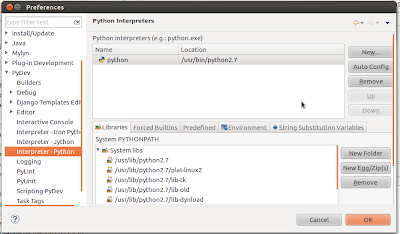한게임머니상 카톡: m6906 / 전화: 010-9331-6906 Hangame is an online community of gamers, who enjoy playing and competing against each other in tournaments and mini-games for cash prizes. The Hangame Money Awards are given out to gamers who show exceptional skill in their chosen game or tournament. These awards come in the form of real money, which can be used to purchase items from the online shop or withdrawn as cash.
Creating Python Google App with Aptana and Pydev




Google App Engine currently support create applications on three different languages: Java, GO and Python. Many developers like to work their projects with a good text editor (Gedit, Notepad++, JEdit, TextMate, MCedit, Vim, etc.) but others go for a sophisticated IDE (Integrated Development Environment). Currently Google gives a plugin for develop Java applications on Eclipse IDE, but not for Python and GO. Lets focus on start a whole project based on Python.
First than all let's start by setting the all environment by downloading the Python SDK from code.google.com. For Windows just install the ".msi" executable and for Linux just extract the ".zip" in your "home" folder. Don't forget to install Python on Windows.
Now let's go to get the Aptana IDE at aptana.com. For Windows just execute the installer and for Linux unpack the ".zip" file and make sure of install Sun Java JDK or JRE (Please not Open JDK). Aptana comes with PHP, HTML, CSS, Javascript, YAML, SQL and more editors. The most I like is the Django Template editor, but we'll get there. Aptana comes by default with a Git client but if you work with SVN take a look at plugin Subclipse.
Aptana is based on the Eclipse framework and therefore is possible to install many Eclipse plugins on it. The plugin that allow coding Python on Aptana (and Eclipse) is Pydev. Once you open Aptana for the first time select the Pydev perspective.
Let's specify the version of Python to Pydev in Aptana. Select "Window -> Preferences -> Pydev -> Intrepeter - Python". Click on the "Auto Config" button or select the path of your Python interpreter on the "New ..." button.
Lets start by creating a new Pydev Google App Engine Project. Select "File -> New -> Project -> Pydev -> Pydev Google App Engine Project".
Make sure to select the correct version of Python for the project and the path for the Google SDK. Look at the images below.
Now we have the development environment complete. I will assume that you have created an application on https://appengine.google.com/. For the next example I will use my own app called djangoabdel (I called like this because I like Django a lot!)
- main.py - This is the start point of the whole application.
- appengine_config.py - At the top level of your project is automatically imported by
google.appengine.ext.webapp.util.run_wsgi_app()to add middlewear to webapp applications. This is how I specify Django version (1.0, 1.1 or 1.2). Take a look at. - app.yaml - The heart of the app configuration.
- templates - folder that will contain static files like images, css files, javascript files, etc. This is the UI of your application.
- controllers - python package that contains all the controllers or business scripts of our application.
- models - python package that contains all the models or Entities of our application.
- libs - python package that contains all the third party libraries.






























This was the best description of setting up Aptana for App Engine development that I've found, but I have one question: I don't get a "Pydev: Google App Engine -> Upload" (or in fact any "Pydev: Google App Engine" options). Any idea what I'm missing?
ReplyHi Derek!
I am glad that I have helped someone with this small tutorial. First than all the project must be created as a Pydev Google App Engine project. Take a closer look at image #4 where the project is created (File -> New -> Project -> Pydev -> Pydev Google App Engine Project). After this when the project is created just right click on the project folder in the view "Pydev Package Explorer"(penultimate image).
Hello Abdel:
ReplyThanks for the tutorial.
Issuue#1:
I was able to create a "hello webapp world" sample for Google App engine, and ran it with no errors with dev_appserver.py, but it does not stop at the breakpoint.
I set the break point in the class method like so:
class MainPage(webapp.RequestHandler):
def get(self):
self.response.headers['Content-Type'] = 'text/plain'
self.response.out.write('Hello, webapp World !') # <<== Break point is here.
I was able to see the response using localhost:8080 on Firefox.
So the sample code is working, but breakpoint is not working.
Issue#2:
I did not see ay short cuts for displaying different views like package Explorer.
I have the latest Aptana studio (3.4) download on for Linux.
Please advice.
thanks.
mmorpg oyunlar
Replyinstagram takipçi satın al
tiktok jeton hilesi
tiktok jeton hilesi
saç ekim antalya
Takipçi Satın Al
İnstagram Takipçi Satın Al
METİN PVP
instagram takipçi satın al